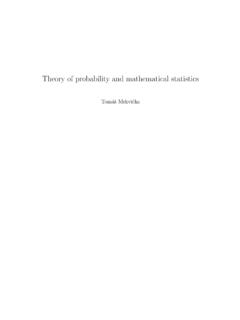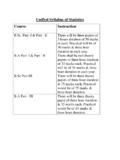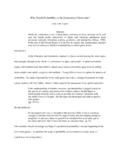Transcription of SHIVAJI UNIVERSITY DEPARTMENT OF …
1 (Stat) Acad Flexib. Pg No. SHIVAJI UNIVERSITY , kolhapur 1 SHIVAJI UNIVERSITY DEPARTMENT OF statistics kolhapur ( statistics ) syllabus (Revised) to be effective from the Academic Year 2006-2007. STRUCTURE The following table gives the scheme of Examination at statistics according to the Revised Syllabus and pattern of Examination. Notations : A six-character code is given to each paper. In MST M stands for and ST stands for statistics . The first digit following MST is Semester Number. The second digit 0 stands for the compulsory theory paper., the digit 1 stands for a practical paper and the digit 2 stands for an elective paper / project work. The third digit indicated the serial number of paper in that semester. Semester No. Paper No. Title of the Paper I MST-101 Statistical Mathematics I MST-102 Statistical Mathematics II MST-103 Distribution Theory MST-104 Estimation Theory MST-105 Statistical Computing MST-116 Practical I II MST-201 Probability Theory MST-202 Theory of Testing of Hypotheses MST-203 Multivariate Analysis MST-204 Linear Models & Design of Experiments MST-205 Sampling Theory MST-216 Practical II III MST-301 Asymptotic Inference MST-302 Elementary Stochastic Processes MST-303 Planning and Analysis of Industrial Experiments.
2 MST-304 Practical III Elective Papers from which Any Two are to be chosen: MST-321 Reliability Theory MST-322 Regression Analysis MST-323 Statistical Genetics MST-324 Measure Theory MST-325 Demography MST-326 Medical statistics MST-327 Advanced Stochastic Processes MST-328 Actuarial statistics MST-329 Dissertation (Stat) Acad Flexib. Pg No. SHIVAJI UNIVERSITY , kolhapur 2 Semester No. Paper No. Title of the Paper IV MST-401 Optimization Techniques MST-402 Decision Theory MST-416 Practical IV and Project Elective Papers from which Any Three are to be chosen: MST-421 Discrete Data Analysis MST-422 Survival Analysis MST-423 Industrial statistics MST-424 Time Series Analysis MST-425 Statistical Ecology MST-426 Econometrics MST-427 Advanced Multivariate Analysis MST-428 Data Mining MST-429 Dissertation Note :- a) Syllabus for some Elective courses has been given.
3 Depending on need and demand, syllabus for other elective courses listed or of new elective courses will be submitted for approval. b) There shall be CIE pattern in which internal examination will be for 30 marks, while UNIVERSITY examination will be for 70 marks. Proposed nature of the Theory and Practical Question Paper at the statistics course under the Semester Schemes. 1. Nature of the theory question papers. a) There shall be 7 questions each carrying 14 marks. b) Question is compulsory and shall contain 10 short sub-questions each carrying 2 marks. Students have to attempt any 7 sub-questions. c) Students have to attempt any 4 questions from question No. 2 to 7. d) Question No. 2 to 6 shall contain 2 to 4 sub-questions. e) Question No. 7 will be short note type. Students are expected to solve any 4 out of 6, each carrying marks. 2. Practical Paper :- a) Semester I,II,III " Practical MST 116, MST 216, MST 316".
4 Internal(30) : There shall be 10 marks for day-to-day journal and internal test will be for 20 marks. End of Term Examination (70): Practical Examination will be of 3 hrs. duration carrying 60 marks. There shall be 8 questions each of 12 marks, of which a student has to attempt any 5 questions. VIVA will be for 10 marks. b) For Semester IV : MST-416 (Stat) Acad Flexib. Pg No. SHIVAJI UNIVERSITY , kolhapur 3 Internal(30) : There shall be 10 marks for day-to-day journal and internal test will be for 20 marks. End of Term Examination (70) : i) Practical Examination will be conducted for 30 marks and is of hours (90 Min.) duration. There shall be 5 questions each carrying 10 marks, of which a student has to attempt any 3 questions. ii) Project work carries 25 marks. Project work consists of collecting data and analyzing the data and preparing report.
5 10 marks are reserved for VIVA. iii) There will be a compulsory study tour. Study tour report be submitted along with practical journal, which will be evaluated for 5 marks. MST 101 : STATISTICAL MATHEMATICS - I 1. Set of real numbers, countable and uncountable sets, countability of rationals and uncountability of the interval (0,1) Supremum and Infimum of bounded sets, limit point of a set, open, closed, dense and compact sets. Bolzano-Weierstrass and Heine-Borel Theorems (Statements only). Applications of these theorems. (10) 2. Sequence of real numbers, convergence, divergence. Cauchy sequence. Convergence of bounded monotone sequence. Limit inferior and limit superior of the sequences. (12) 3. Series of numbers, tests for convergence (without proof) test for absolute convergence, convergence of sequences of non-negative terms. (6) 4. Real valued function, continuous function, Uniform continuity of sequence of functions, Uniform convergence of power series, radius of convergence.
6 (4) 5. Vector and Matrix differentiation, Maxima, minima of functions of several variables. Constrained maxima, minima, Lagrange s method, Taylor s theorem (without proof) and its applications (4) 6. Riemann, Riemann-Steltjes Integrals. Integration by parts, mean value theorem, their applications in finding functionals of distributions. (4) 7. Multiple integrals, Change of variables, Improper integrals, Applications in multivariate distributions. Uniform convergence, theorem on differentiation under integral sign (without proof), Leibnitz rule (statement only) and applications. (5) References: 1. Malik S. C. & Arora S.(1991) : Mathematical Analysis- Wiley Eastern Limited IInd edition. (Stat) Acad Flexib. Pg No. SHIVAJI UNIVERSITY , kolhapur 42. Goldberg R. R. (1964) : Methods of Real Analysis- Blaisdell Publishing company, New york, 3.
7 Bartle G. R. ( 1976): Element of Real Analysis- Wiley 2nd edition. 4. Bartle & Sherbert D. R. ( 2000): Introduction to Real Analysis- John Wiley & Son Inc. 5. Royden (1988) : Principles of Real Analysis - Macmillian. 6. Widder (1989) : Advanced Calculus - Dover Publication. 7 . Apostol ( 1985) : Mathematical Analysis - Narosa Publishing House, MST 102 : STATISTICAL MATHEMATICS - II 1. Vector space, subspace, linear dependence and independence, basis, dimension of a vector space, example of vector spaces. (8) 2. Null space, Special types of matrices: elementary operations, rank of a matrix. Orthonormal basis, and orthogonal projection of a vector. Gram-Schmidt orthogonalisation, Kronekar product. Idempotent matrices, inverse of a matrix, their simple properties, Partitioned Matrices, Orthogonal matrices. (10) 3. Characteristic roots of a matrix, algebraic and geometric multiplicities, characteristic vectors and their orthogonal property.
8 Caley-Hamilton Theorem and applications. (8) 4. Spectral decomposion and G-inverse Moore Penrose inverse, Solution of a system of homogenous and non-homogenous linear equations, and theorem related to existence of solution. (10) 5. Quadratic forms: definition, reduction, simultaneous reduction of two quadratic forms, maxima and minima of ratio of quadratic forms. (10) References: 1. Rao A. R. & Bhimashankaram P. ( 1992) : Linear Algebra. Tata Mc-Graw Hill, New Delhi. 2. Hadely G (1987): Linear Algebra - Narosa Publishing House. 3. Rao C. R. ( 1973) : Linear Statistical Inference and Its Applications , Second Edition Wiley Eastern. 4. Searl S. B.(1982) : Matrix Algebra Useful for statistics Wiley 5. Graybill , (1961) : An introduction to linear Statistical models Vol-I- McGraw-Hill Book company Inc. MST 103 : DISTRIBUTION THEORY (Stat) Acad Flexib.
9 Pg No. SHIVAJI UNIVERSITY , kolhapur 5 Unit-1: Brief review of basic distribution theory. Distribution function and its properties, Relation of distribution function with uniform distribution. Decomposition of distribution function into discrete and continuous parts. (6) Unit-2: Functions of random variables, their distribution in case of univariate random variables and its applications. (6) Unit-3: Expectation and moments, probability generating function, moment generating function, convolution and examples. (5) Unit-4: Moment inequalities:- Markov, Chebychev, Holder, Minkowski and Jensen inequalities with their applications. Basic inequality Liapunov s. (6) Unit-5: Bivariate discrete and continuous distributions, marginal distributions. Examples of many joint with given marginal distributions. Independence, conditional , distributions and examples. Distribution of function of bivariate random variables using Jacobian of transformation.
10 (5) Unit-6: Multinomial distribution, Bivariate Poisson, Bivariate exponential and Bivariate normal distribution and their properties. Dirichilet distribution. (6) Unit-7: Symmetric distributions, properties of symmetric distributions, non-regular families, location and scale families and examples. (3) Unit-8: Order statistics - distribution of ith order statistic, joint distribution of (i,j)th order statistics , independence of exponential spacing & examples. (3) References: 1. Rohatagi Saleh A. K. Md. E.(2001) : Introduction to Probability Theory and Mathematical statistics - John Wiley and sons Inc. 2. Johnson N. L. & Kotz. S. (1996) : Distributions in statistics Vol-I,II and III- John Wiley and Sons New york. 3. Johnson & S. Kotz. John : Multivariate Distributions - Wiley and sons New york. 4. Casella & Berger (2002) : Statistical Inference - Duxbury advanced series. IInd edition MST 104 : ESTIMATION THEORY (Stat) Acad Flexib.
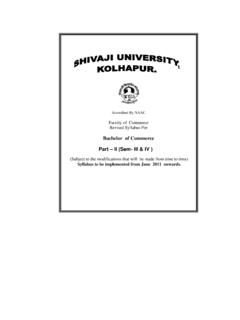
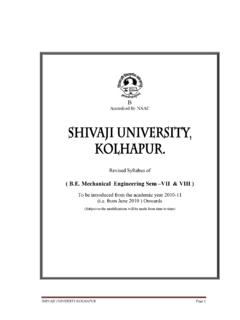

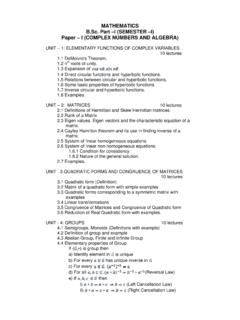

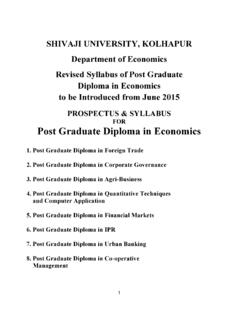



![Revised Syllabus For B.Sc, Part III [Mathematics] …](/cache/preview/d/b/6/0/d/d/1/e/thumb-db60dd1ea7378bffcc12e6f47a9540f5.jpg)
